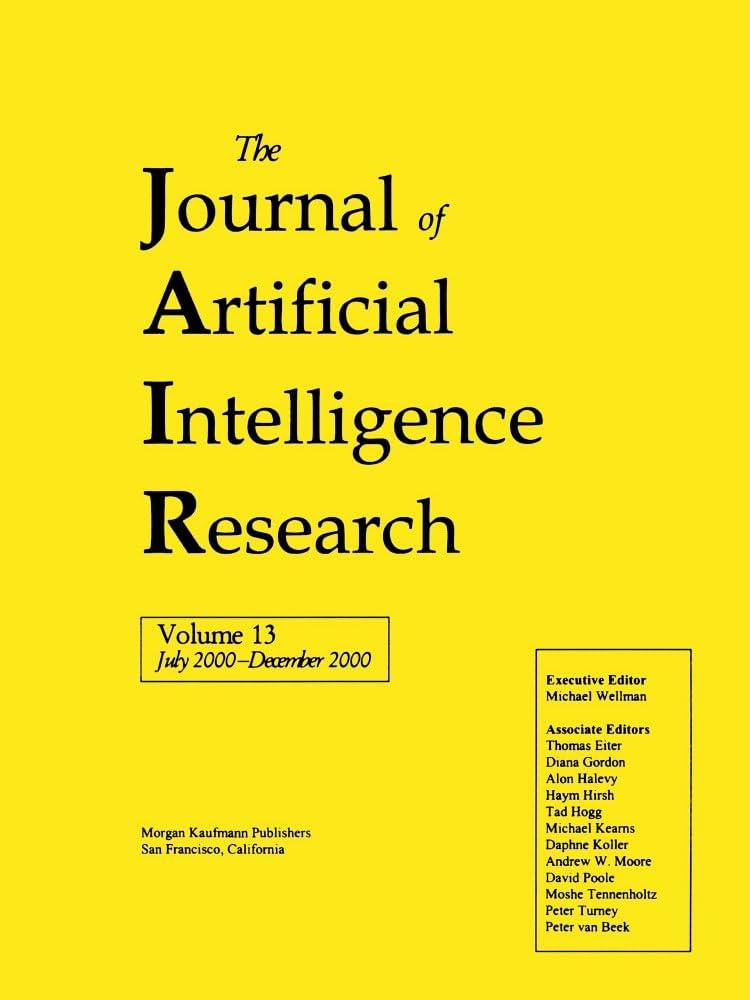Dynamic Controllability of Temporal Plans in Uncertain and Partially Observable Environments
IF 4.5
3区 计算机科学
Q2 COMPUTER SCIENCE, ARTIFICIAL INTELLIGENCE
引用次数: 0
Abstract
The formalism of Simple Temporal Networks (STNs) provides methods for evaluating the feasibility of temporal plans. The basic formalism deals with the consistency of quantitative temporal requirements on scheduled events. This implicitly assumes a single agent has full control over the timing of events. The extension of Simple Temporal Networks with Uncertainty (STNU) introduces uncertainty into the timing of some events. Two main approaches to the feasibility of STNUs involve (1) where a single schedule works irrespective of the duration outcomes, called Strong Controllability, and (2) whether a strategy exists to schedule future events based on the outcomes of past events, called Dynamic Controllability. Case (1) essentially assumes the timing of uncertain events cannot be observed by the agent while case (2) assumes full observability. The formalism of Partially Observable Simple Temporal Networks with Uncertainty (POSTNU) provides an intermediate stance between these two extremes, where a known subset of the uncertain events can be observed when they occur. A sound and complete polynomial algorithm to determining the Dynamic Controllability of POSTNUs has not previously been known; we present one in this paper. This answers an open problem that has been posed in the literature. The approach we take factors the problem into Strong Controllability micro-problems in an overall Dynamic Controllability macro-problem framework. It generalizes the notion of labeled distance graph from STNUs. The generalized labels are expressed as max/min expressions involving the observables. The paper introduces sound generalized reduction rules that act on the generalized labels. These incorporate tightenings based on observability that preserve dynamic viable strategies. It is shown that if the generalized reduction rules reach quiescence without exposing an inconsistency, then the POSTNU is Dynamically Controllable (DC). The paper also presents algorithms that apply the reduction rules in an organized way and reach quiescence in a polynomial number of steps if the POSTNU is Dynamically Controllable. Remarkably, the generalized perspective leads to a simpler and more uniform framework that applies also to the STNU special case. It helps illuminate the previous methods inasmuch as the max/min label representation is more semantically clear than the ad-hoc upper/lower case labels previously used.不确定和部分可观测环境下时间计划的动态可控性
简单时态网络(STNs)的形式化为评估时态规划的可行性提供了方法。基本的形式主义处理计划事件的定量时间需求的一致性。这隐含地假设单个代理完全控制事件的时间。具有不确定性的简单时间网络(STNU)的扩展将不确定性引入到某些事件的时序中。STNUs可行性的两种主要方法包括:(1)单个调度不考虑持续结果,称为强可控性;(2)是否存在基于过去事件的结果来调度未来事件的策略,称为动态可控性。情形(1)本质上假定不确定事件的时间不能被agent观察到,而情形(2)假定完全可观察。具有不确定性的部分可观察简单时间网络(POSTNU)的形式化提供了这两个极端之间的中间立场,其中当不确定事件发生时可以观察到已知子集。一种完善的多项式算法来确定POSTNUs的动态可控性,这在以前是未知的;我们在本文中提出了一个。这回答了文献中提出的一个开放性问题。该方法在整体动态可控性宏观问题框架中,将问题分解为强可控性微观问题。它推广了标记距离图的概念。广义标签表示为涉及可观测值的max/min表达式。本文介绍了作用于广义标签的健全的广义约简规则。这些措施包括基于可观察性的收紧措施,以保持动态可行的策略。证明了如果广义约简规则达到静止状态而不暴露不一致性,则POSTNU是动态可控的(DC)。本文还提出了在POSTNU动态可控的情况下,有组织地应用约简规则的算法,并在多项式步数内达到静态。值得注意的是,广义的观点导致了一个更简单、更统一的框架,也适用于上海师范大学的特殊情况。它有助于阐明以前的方法,因为最大/最小标签表示比以前使用的特别的大写/小写标签在语义上更清晰。
本文章由计算机程序翻译,如有差异,请以英文原文为准。
求助全文
约1分钟内获得全文
求助全文
来源期刊

Journal of Artificial Intelligence Research
工程技术-计算机:人工智能
CiteScore
9.60
自引率
4.00%
发文量
98
审稿时长
4 months
期刊介绍:
JAIR(ISSN 1076 - 9757) covers all areas of artificial intelligence (AI), publishing refereed research articles, survey articles, and technical notes. Established in 1993 as one of the first electronic scientific journals, JAIR is indexed by INSPEC, Science Citation Index, and MathSciNet. JAIR reviews papers within approximately three months of submission and publishes accepted articles on the internet immediately upon receiving the final versions. JAIR articles are published for free distribution on the internet by the AI Access Foundation, and for purchase in bound volumes by AAAI Press.
 求助内容:
求助内容: 应助结果提醒方式:
应助结果提醒方式:


